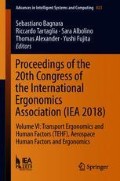Abstract
Whether internal body loads such as muscle forces and joint forces could be used as objective factors to assess sitting discomfort remains an open research question. The present study investigated the potential relationship between computationally predicted internal loads and subjective discomfort ratings. Volunteers were recruited to provide discomfort ratings on a wide range of sitting configurations resulted in by altering the seat pan angle and the backrest angle of a multi-adjustable experimental seat. Moreover, two preferred seat pan angles were selected by the participants, starting from two different initial seat pan angles, allowing the classification of the trials to preferred and not preferred. Kinematic, force and pressure data served as inputs on a musculoskeletal model that enabled the computation of internal loads. Significant positive correlations were found between the subjective ratings and muscle force, compressive force between L4–L5 and seat pan shear force. Significant reduction in the seat pan shear force was found for the preferred compared to the not preferred trials, but no significant differences were found for the muscle and joint forces. Our results suggest that the seat pan shear force and potentially computationally predicted internal loads could be used to assess sitting discomfort. However, the outcome should be interpreted with caution due to limited number of observations.
Access this chapter
Tax calculation will be finalised at checkout
Purchases are for personal use only
References
de Looze MP, Kuijt-Evers LFM, van Dieen J (2003) Sitting comfort and discomfort and the relationships with objective measures. Ergonomics 46(10):985–997
Andersson BJG, Ortengren R, Nachemson A, Elfstrom G (1974) Lumbar disc pressure and myoelectric back muscle activity during sitting. IV. Studies on a car driver’s seat. Scand J Rehabil Med 6:128–133
Wilke HJ, Neef P, Caimi M, Hoogland T, Claes LE (1999) New in vivo measurements of pressures in the intervertebral disc in daily life. Spine 24:755–762
Zenk R, Franz M, Bubb H, Vink P (2012) Technical note: spinal loading in automotive seating. Appl Ergon 43:290–295
Grujicic M, Pandurangan B, Xie X, Gramopadhye A, Wagner D, Ozen M (2010) Musculoskeletal computational analysis of the influence of car-seat design/adjustments on long-distance driving fatigue. Int J Ind Ergon 40(3):345–355
Rasmussen J, Torholm S, de Zee M (2009) Computational analysis of the influence of seat pan inclination and friction on muscle activity and spinal joint forces. Int J Ind Ergon 39:52–57
Cappetti N, Naddeo A, Soldovieri VM, Vitillo I (2017) A study on the correlation between the perceived comfort and the muscular activity, using virtual simulation techniques. In: 1st International comfort congress. Publisher, Salerno, pp 1–2
Beurier G, Cardoso M, Wang X (2017) A new multi-adjustable experimental seat for investigating biomechanical factors of sitting discomfort. SAE Technical Paper 2017-01-139
Wang X, Beurier X (2018) Determination of the optimal seat profile parameters for an airplane eco-class passenger seat. SAE Technical Paper 2018-01-1324. SAE world congress 2018, 10–12 April 2018, Detroit, USA. https://doi.org/10.4271/2018-01-132
Shen W, Parsons KC (1997) Validity and reliability of rating scales for seated pressure discomfort. Int J Ind Ergon 20:441–461
Nerot A, Skalli W, Wang X (2016) A principal component analysis of the relationship between the external body shape and internal skeleton for the upper body. J Biomech 49(14):3415–3422
Andersen MS, Damsgaard M, MacWilliams B, Rasmussen J (2010) A computationally efficient optimisation-based method for parameter identification of kinematically determinate and over-determinate biomechanical systems. Comput Methods Biomech Biomed Eng 13(2):171–183
Andersen MS, Damsgaard M, Rasmussen J (2009) Kinematic analysis of over-determinate biomechanical systems. Comput Methods Biomech Biomed Eng 12(4):371–384
Damsgaard M, Rasmussen J, Christensen ST, Surma E, de Zee M (2006) Analysis of musculoskeletal systems in the AnyBody Modeling System. Simul Model Pract Theory 14(8):1100–1111
Frankenfield DC, Rowe WA, Cooney RN, Smith JS, Becker D (2001) Limits of body mass index to detect obesity and predict body composition. Nutrition 17(1):26–30
Acknowledgement
The work is partly supported by Direction Générale de l’Aviation Civile (project n°2014 930818).
Author information
Authors and Affiliations
Corresponding author
Editor information
Editors and Affiliations
Rights and permissions
Copyright information
© 2019 Springer Nature Switzerland AG
About this paper
Cite this paper
Theodorakos, I., Savonnet, L., Beurier, G., Wang, X. (2019). Can Computationally Predicted Internal Loads Be Used to Assess Sitting Discomfort? Preliminary Results. In: Bagnara, S., Tartaglia, R., Albolino, S., Alexander, T., Fujita, Y. (eds) Proceedings of the 20th Congress of the International Ergonomics Association (IEA 2018). IEA 2018. Advances in Intelligent Systems and Computing, vol 823. Springer, Cham. https://doi.org/10.1007/978-3-319-96074-6_47
Download citation
DOI: https://doi.org/10.1007/978-3-319-96074-6_47
Published:
Publisher Name: Springer, Cham
Print ISBN: 978-3-319-96073-9
Online ISBN: 978-3-319-96074-6
eBook Packages: Intelligent Technologies and RoboticsIntelligent Technologies and Robotics (R0)

